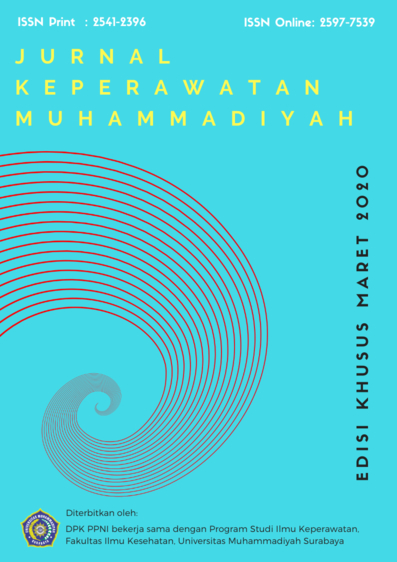Uji FTIR dan uji fitokimia dari madu trigona spp. Untuk persiapan suplemen wanita prakonsepsi
DOI:
https://doi.org/10.30651/jkm.v5i2.4099Keywords:
FTIR, Flavonoids, Polyphenols, Trigona spp. honey, AntioxidantsAbstract
Objective: This study aims to identify functional groups and chemical compounds using FTIR (Fourier Transform Infrared), phytochemical tests to identify the content of saponins, tannins, flavonoids, alkaloids, terpenoids and steroids using chemical solutions and total phenol test using 20D+ spectroscopy to determine the amount of polyphenols in Trigona spp. honey. This research is a laboratory study conducted at the Integrated Chemistry Laboratory and Biochemistry Laboratory, Faculty of Mathematics and Natural Sciences, Hasanuddin University Makassar. The sample used in the study was Trigona spp. honey which is a local livestock honey from Masamba, North Luwu regency, South Sulawesi, and has been processed by the Halal Center of Hasanuddin University Makassar.
Results: Flavonoids and polyphenols were found in phytochemical tests using Pb(CH3COO)2 and FeCl3 reagents. The FTIR test results indicate the presence of phenolic structures included in the flavonoid group. The total phenolic results from the total phenol test on Trigona spp. honey samples. The amount of polyphenols was 0.28%.
Conclusion: This study concluded that there are flavonoids and polyphenols in honey Trigona spp. with a total phenol of 0.28%. Trigona spp. honey has antioxidant effects, so it is well used as a complementary therapeutic supplement for preconception women for handling reproductive health problems.References
Alqarni, A. S. et al. (2014) ‘Mineral content and physical properties of local and imported honeys in Saudi Arabia’, Journal of Saudi Chemical Society. King Saud University, 18(5), pp. 618–625. doi: 10.1016/j.jscs.2012.11.009.
Ãvila, S. et al. (2018) ‘Stingless bee honey: Quality parameters, bioactive compounds, health-promotion properties and modification detection strategies’, Trends in Food Science and Technology, 81(August), pp. 37–50. doi: 10.1016/j.tifs.2018.09.002.
Behlil, F. et al. (2019) ‘Phytochemical screening and antioxidant activity determination of some medicinally important plants of balochistan’, Pakistan Journal of Botany, 51(2), pp. 601–608. doi: 10.30848/PJB2019-2(14).
Can, Z. et al. (2015) ‘An investigation of Turkish honeys: Their physico-chemical properties, antioxidant capacities and phenolic profiles’, Food Chemistry. Elsevier Ltd, 180, pp. 133–141. doi: 10.1016/j.foodchem.2015.02.024.
Chuttong, B. et al. (2016) ‘Physicochemical
profiles of stingless bee (Apidae: Meliponini) honey from South East Asia (Thailand)’, Food Chemistry. Elsevier Ltd, 192, pp. 149–155. doi: 10.1016/j.foodchem.2015.06.089.
Erejuwa, O. O. et al. (2012) ‘Honey Supplementation in Spontaneously Hypertensive Rats Elicits Antihypertensive Effect via Amelioration of Renal Oxidative Stress’, Oxidative Medicine and Cellular Longevity, 2012, pp. 1–14. doi: 10.1155/2012/374037.
Gul, R. et al. (2017) ‘Preliminary Phytochemical Screening, Quantitative Analysis of Alkaloids, and Antioxidant Activity of Crude Plant Extracts from Ephedra intermedia Indigenous to Balochistan’, Scientific World Journal, 2017(Figure 1). doi: 10.1155/2017/5873648.
Islam, M. A. et al. (2012) ‘Physicochemical and antioxidant properties of Bangladeshi honeys stored for more than one year’, BMC Complementary and Alternative Medicine, 12(1), p. 177. doi: 10.1186/1472-6882-12-177.
Jaradat, N., Hussen, F. and Ali, A. Al (2015) ‘Preliminary phytochemical screening, quantitative estimation of total flavonoids, total phenols and antioxidant activity of Ephedra alata decne’, Journal of Materials and Environmental Science, 6(6), pp. 1771–1778.
Kolayli, S. et al. (2016) ‘A comparative study of the antihyaluronidase, antiurease, antioxidant, antimicrobial and physicochemical properties of different unifloral degrees of chestnut (Castanea sativa Mill.) honeys’, Journal of Enzyme Inhibition and Medicinal Chemistry, 31(July), pp. 96–104. doi: 10.1080/14756366.2016.1209494.
Michener, C. D. (2013) Pot-Honey A legacy of stingless bees. Edited by Patricia Vit, S. R. M. Pedro, and D. W. Roubik. Springer Science+Business Media New York. doi: 10.1007/978-1-4614-4960-7.
Mijanur Rahman, M., Gan, S. H. and Khalil, M. I. (2014) ‘Neurological Effects of Honey: Current and Future Prospects’, Evidence-Based Complementary and Alternative Medicine, 2014, pp. 1–13. doi: 10.1155/2014/958721.
Rajabzadeh, A. et al. (2015) ‘Honey and vitamin E restore the plasma level of gonadal hormones and improve the fertilization capacity in noise-stressed rats.’, Crescent Journal of Medical and Biological Sciences, 2(2), pp. 64–68.
Roghini, R. and Vijayalakshmi, K. (2018) ‘Phytochemical Screening, Quantitative Analysis of Flavonoids and Minerals in Ethanolic Extract of Citrus Paradisi’, International Journal of Pharmaceutical Sciences and Research, 9(11), pp. 4859–4864. doi: 10.13040/IJPSR.0975-8232.9(11).4859-64.
Shantal RodrÃguez Flores, M., Escuredo, O. and Carmen Seijo, M. (2015) ‘Assessment of physicochemical and antioxidant characteristics of Quercus pyrenaica honeydew honeys’, Food Chemistry, pp. 101–106. doi: 10.1016/j.foodchem.2014.06.005.
Da Silva, P. M. et al. (2016) ‘Honey: Chemical composition, stability and authenticity’, Food Chemistry, 196(October), pp. 309–323. doi: 10.1016/j.foodchem.2015.09.051.
Waykar, B. and Alqadhi, Y. A. (2016) ‘Indian Journal of Pharmaceutical and Biological Research ( IJPBR ) Biological Properties and Uses of Honey : A Concise Scientific review’, 4(3), pp. 58–68.
Yaacob, M. et al. (2018) ‘Stingless bee honey and its potential value: A systematic review’, Food Research, 2(2), pp. 124–133. doi: 10.26656/fr.2017.2(2).212.
Zuccato, V. et al. (2017) ‘Entomological authentication of stingless bee honey by 1 H NMR-based metabolomics approach’, Food Control. Elsevier Ltd, 82, pp. 145–153. doi: 10.1016/j.foodcont.2017.06.024.
Downloads
Published
Issue
Section
License
- Penulis tetap memegang hak atas karyanya dan memberikan hak publikasi pertama kepada jurnal ini yang secara simultan karya tersebut dilisensikan di bawah:Â Creative Commons Attribution-ShareAlike 4.0 International (CC BY-SA 4.0)













